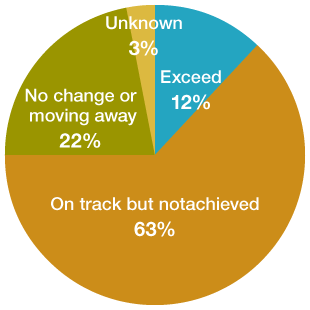June 2022
Biodiversity: the next key focus of ESG investment after climate change

Biodiversity is drawing considerable attention as the next key focus of ESG investment after climate change. While the debate is less mature than on climate change, recent years have featured rapid progress with defining concepts and researching measurement methods. We think the planned adoption of 2030 global biodiversity targets within 2022 will spur interest in biodiversity.
Progress on Biodiversity Targets
Global biodiversity initiatives are occurring within broadly similar overall frameworks to climate change. Governments have signed up to the Convention on Biodiversity (CBD), the equivalent of the United Nations Framework Convention on Climate Change (UNFCCC) in the climate space. As with climate change issues, conferences between these signatories are also under way, with COP15 (the 15th Session of the Conference of the Parties) taking place in October 2021.
Moves toward Post-2020 Global Biodiversity Framework
2021
- October 11-15: Phase one of 15th meeting of Conference of the Parties to the Convention on Biological Diversity (COP15), China
2022
- March 14-27: SBSTTA-24 (24th meeting of Subsidiary Body on Scientific, Technical and Technological Advice), Switzerland
- March 14-28: SBI-3 (third meeting of the Subsidiary Body on Implementation), Switzerland
- March 14-29: OEWG-3 (third meeting of the Open-Ended Working Group on the Post-2020 Global Biodiversity Framework) phase two
- May 22: International Day for Biological Diversity
- June 17-18: SBI-3 Agenda Item 9 workshop on options to enhance planning, monitoring, reporting, and review mechanisms
- June 21-26: OEWG-4 (fourth meeting of the Open-Ended Working Group on the Post-2020 Global Biodiversity Framework), Kenya
- June 29-July 1: Technical meeting on indicators for the Post-2020 Global Biodiversity Framework, Germany
- 3Q (August?): COP15 phase two (China)
- September: Japan's Cabinet to approve draft revisions to national biodiversity strategy (to be presented as early as June)
Note: Timing for phase two of COP15 based on information on websites of Convention on Biological Diversity (CBD) (August) and independent think tank the International Institute for Sustainable Development (IISD) (29 August-9 September); note that both are only provisional.
Source: Nomura, based on Convention on Biological Diversity website, Ministry of the Environment (Japan), other materials
The goal of COP15 is to approve the Post-2020 Global Biodiversity Framework. According to GBO-5 (the fifth edition of the Global Biodiversity Outlook), issued by the CBD secretariat in August 2020, only limited progress was made toward the Aichi Targets (the strategic plan for 2011-2020 adopted at COP10). We think the process of drawing up the Post-2020 Global Biodiversity Framework reflects the lessons learned from the limited success with achieving the Aichi Targets.
Progress toward Aichi Biodiversity Targets

Source: Nomura, based on United Nations data
One lesson learned from this experience is that there were not enough quantitative targets. The Aichi Targets included some quantitative goals, but many yardsticks were only qualitative. We think substantial differences in economic development stage in the developing nations that are key to preserving biodiversity made it difficult to reach agreement on unified global quantitative targets. We think forming a global consensus was a higher priority than setting effective targets when the Aichi goals were drawn up.
These lessons appear to have led to a greater focus on quantitative targets during discussions on the Post-2020 Global Biodiversity Framework. The draft proposals released in July 2021 certainly includes a raft of quantitative goals. The issue will be whether the parties can reach agreement on these targets.
Quantitative targets in draft Post-2020 Global Biodiversity Framework
- Target 2. Ensure that at least 20 per cent of degraded freshwater, marine and terrestrial ecosystems are under restoration, ensuring connectivity among them and focusing on priority ecosystems.
- Target 3. Ensure that at least 30 per cent globally of land areas and of sea areas, especially areas of particular importance for biodiversity and its contributions to people, are conserved through effectively and equitably managed, ecologically representative and well-connected systems of protected areas and other effective area-based conservation measures, and integrated into the wider landscapes and seascapes.
- Target 6. Manage pathways for the introduction of invasive alien species, preventing, or reducing their rate of introduction and establishment by at least 50 per cent, and control or eradicate invasive alien species to eliminate or reduce their impacts, focusing on priority species and priority sites.
- Target 7. Reduce pollution from all sources to levels that are not harmful to biodiversity and ecosystem functions and human health, including by reducing nutrients lost to the environment by at least half, and pesticides by at least two thirds and eliminating the discharge of plastic waste.
- Target 8. Minimize the impact of climate change on biodiversity, contribute to mitigation and adaptation through ecosystem-based approaches, contributing at least 10 GtCO2e per year to global mitigation efforts, and ensure that all mitigation and adaptation efforts avoid negative impacts on biodiversity.
- Target 15. All businesses (public and private, large, medium and small) assess and report on their dependencies and impacts on biodiversity, from local to global, and progressively reduce negative impacts, by at least half and increase positive impacts, reducing biodiversity-related risks to businesses and moving towards the full sustainability of extraction and production practices, sourcing and supply chains, and use and disposal.
- Target 16. Ensure that people are encouraged and enabled to make responsible choices and have access to relevant information and alternatives, taking into account cultural preferences, to reduce by at least half the waste and, where relevant the overconsumption, of food and other materials.
- Target 18. Redirect, repurpose, reform or eliminate incentives harmful for biodiversity, in a just and equitable way, reducing them by at least US$ 500 billion per year, including all of the most harmful subsidies, and ensure that incentives, including public and private economic and regulatory incentives, are either positive or neutral for biodiversity.
- Target 19. Increase financial resources from all sources to at least US$ 200 billion per year, including new, additional and effective financial resources, increasing by at least US$ 10 billion per year international financial flows to developing countries, leveraging private finance, and increasing domestic resource mobilization, taking into account national biodiversity finance planning, and strengthen capacity-building and technology transfer and scientific cooperation, to meet the needs for implementation, commensurate with the ambition of the goals and targets of the framework.
Note: We excerpt only the sections of the July 2021 draft that refer to quantitative targets. Red text in the figure indicates the quantitative aspects of each target.
Source: Nomura, based on United Nations data
The global turmoil caused by the COVID-19 pandemic was naturally one of the reasons for COP15's two-part structure. We also think that the process of establishing a consensus on the Post-2020 Global Biodiversity Framework is behind schedule. The initial timeline envisaged a broad-brush agreement on the framework via the March round of meetings (SBSTTA-24, SBI-3, OEWG-3), and official adoption during phase two of COP15, which was planned for April 25-May 8. However, the March meetings failed to reach sufficient agreement, and the CBD secretariat indicates that further preparatory meetings are scheduled for June; it has announced only a provisional schedule for phase two of COP15, the official forum for approval, of "July-September 2022". Further evidence of this can be found in the numerous brackets (reflecting unresolved differences between countries' views) in the March meeting outcome documents.
However, discussions are naturally moving ahead. A summary from Japan's MOE notes that the March round of meetings resulted in many countries' support for: (1) the 30 by 30 targets for protecting and preserving 30% of land and ocean area by 2030; (2) the use of nature-based solutions that contribute to mitigation and adaption (in relation to proposed climate change and biodiversity targets); and (3) government efforts to encourage companies to disclose their impact and reliance on nature and reduce their negative impact (in relation to proposed business and biodiversity targets).
Biodiversity Disclosure Developments
Alongside the process of setting global targets in the CBD, progress is also being made on creating frameworks for biodiversity and natural capital disclosures. Recommendations made by the Taskforce on Climate-related Financial Disclosures (TCFD) have already been adopted around the world, and in Japan too, companies listed on the Prime Market from April of this year will be required to make disclosures based on TCFD standards. In a similar way, the Taskforce on Nature-related Financial Disclosures (TNFD) was set up to tackle biodiversity, and released v0.1 of its proposed disclosure framework in March 2022. Given the likelihood that TNFD recommendations will act as the global framework for biodiversity disclosure, we think attention will focus on progress with revising this draft. Based on opinions from users and other interested parties regarding v0.1, TNFD is scheduled to compile revisions in June 2022, October 2022, and February 2023, and release the final version in September 2023.
Pilot tests of the TNFD disclosure framework are scheduled to start from June 2022. The insights from the pilot tests will be an important input for the final version of the framework. It will release additional guidance for financial institutions and other corporates that will participate in the pilot tests alongside v0.2. From FY22 H2 through FY23 H1 (pilot testing is through end-June 2023), we focus on an increase in corporate disclosure based on the TNFD framework.
Summary from “ESG Research: policy update” (March 21, 2022) and “Nomura ESG Monthly” (May 19, 2022)



